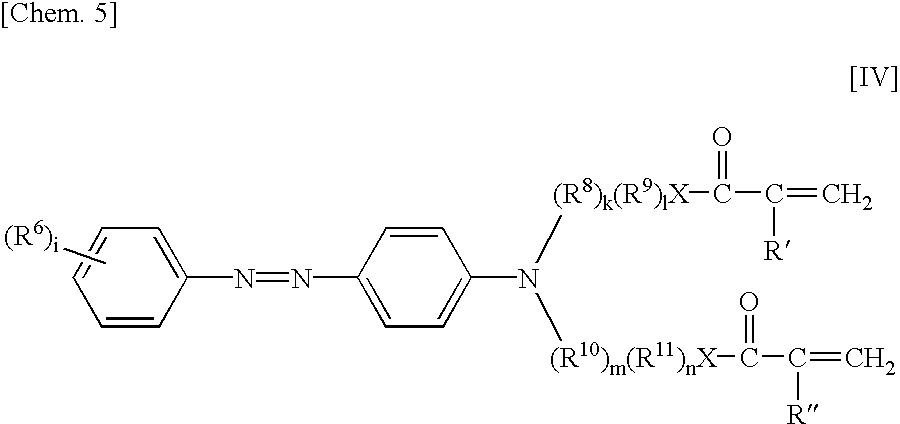Dye for an intraocular lens and an intraocular lens using it
a technology of intraocular lens and dyeing technology, applied in the direction of instruments, prosthesis, organic chemistry, etc., can solve the problems of eye injury, especially light damage to the retina, and the inability of ultraviolet light to reach the retina,
- Summary
- Abstract
- Description
- Claims
- Application Information
AI Technical Summary
Problems solved by technology
Method used
Image
Examples
synthetic example 1
Synthesis of Compound 1
1. Synthesis of Diazonium Benzoate
P-amino benzoic acid 6.86 g (0.05 mol) was placed in a three necked flask of 1000 ml, 1 mol / l of hydrochloric acid 100 ml was added to dissolve the mixture. A mechanical stirrer, a thermometer and a dropping funnel of 200 ml were attached to the three-necked flask. The flask was placed in an ice bath, and the temperature in the flask was kept at 0-5° C. Sodium nitrite (NaNO2) 3.8 g (0.055 mol) was dissolved in 10 ml of distilled water, and the solution was slowly added dropwise from the neck into the flask for five minutes. The temperature in the flask was kept at 0-5° C., stirring was continued for 30 minutes, and yellow liquid was obtained to use for next reaction.
2. Synthesis of 4-(4′-carboxyphenylazo)-3-methyl-1-phenylpyrazolone by azo coupling reaction
3-Methyl-1-phenylpyrazolone 10.45 g (0.06 mol) was dissolved in 1 mol / l of aqueous solution of sodium hydroxide 100 ml and the solution was placed into the above dropping fu...
synthetic example 2
Synthesis of Compound 2
1. Synthesis of a diazonium salt of 4-aminostyrene
1 N hydrochloric acid 100 ml was placed into a 1000 ml three necked flask equipping with a thermometer, and 4-aminostyrene 2.5 g was added and dissolved. Ice cooling the flask, an aqueous solution 10 ml of sodium nitrite 1.45 g was slowly added for about ten minutes. All reaction solution was changed into green brown.
2. Synthesis of 3-methyl-1-phenyl-4-(4-vinylphenylazo)-5-pyrazolone by azo coupling reaction
3-methyl-1-phenylpyrazolone 3.7 g was dissolved in 1 N aqueous solution 200 ml of sodium hydroxide. The solution was placed in a dropping funnel, and slowly added dropwise for about one hour into the solution prepared in above 1. With dropping, a red brown precipitate was produced in the solution. After the dropping was finished, the solution was warmed to room temperature, and stirred for one hour. Measuring with a pH meter, 1 N hydrochloric acid was added to obtain a solution of pH 2. The solution was filt...
synthetic example 3
Synthesis of Compound 3
4-aminoazobenzene 1 g was dissolved in a mixture of ethanol 40 ml and toluene 5 ml in an oval flask of 200 ml, and allyl bromide 10 ml was added. The flask was immersed in an oil bath at 80° C. and heated to reflux the mixture for 30 minutes. Then, by adding NaOH 2 g, the color of the solution was changed into greenish yellow. Allyl bromide 10 ml was further added, and the mixture was refluxed at 80° C. for 30 minutes. After the reaction was finished, dichloromethan 100 ml was added, and the solution was washed with 1N NaOH aqueous solution three times and water 100 ml three times. The dichloromethane layer was taken out and the solvent was distilled away with an evaporator. After adding a small amount of ethanol, the mixture was submitted to heat filtration and cooled in a refrigerator. Needle crystals separated out. The obtained crystals were filtered and dried in vacuo to obtain crystals of the aimed compound.
Embodying examples of the present invention are ...
PUM
 Login to View More
Login to View More Abstract
Description
Claims
Application Information
 Login to View More
Login to View More - R&D
- Intellectual Property
- Life Sciences
- Materials
- Tech Scout
- Unparalleled Data Quality
- Higher Quality Content
- 60% Fewer Hallucinations
Browse by: Latest US Patents, China's latest patents, Technical Efficacy Thesaurus, Application Domain, Technology Topic, Popular Technical Reports.
© 2025 PatSnap. All rights reserved.Legal|Privacy policy|Modern Slavery Act Transparency Statement|Sitemap|About US| Contact US: help@patsnap.com



